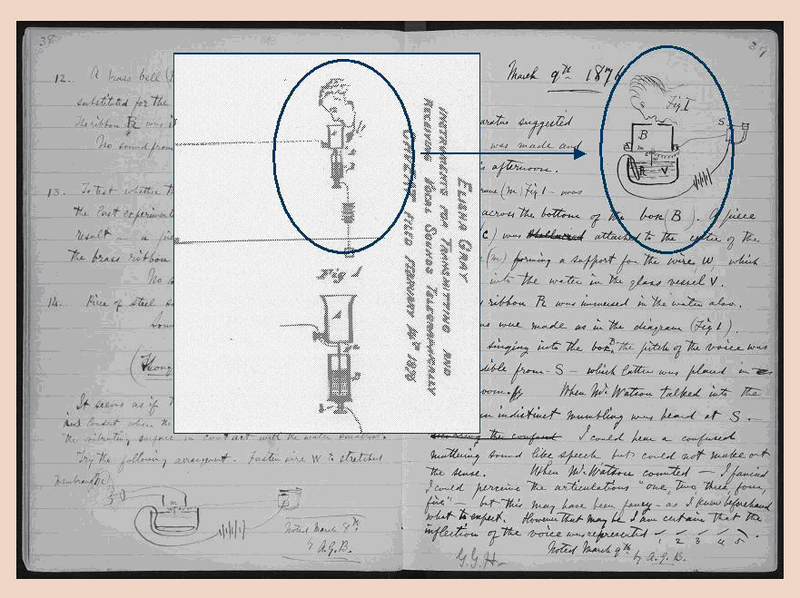American electrical engineer Elisha Gray was one of the co-founders of the Western Electric Manufacturing Company and also developed the telephone prototype in 1876. More recently, authors and historians have argued that he was the true inventor of the telephone and Alexander Graham Bell, who is credited with inventing it, allegedly stole his idea of using a liquid transmitter.
Elisha Gray was born on August 2, 1835 in Barnesville, Ohio to Quaker parents. He grew up on a farm before going to Oberlin College. There, he first began experimenting with electrical devices. He did not end up graduating from Oberlin, but did teach science and electricity at the school and built laboratory equipment. In 1862, Gray met Delia Minerva Shepard at Oberlin and the two got married that same year.
When he was thirty, he invented a self-adjusting telegraph relay in 1865. The invention automatically adapted to the varying insulations of telegraph lines. Two years later, Gray received a patent for his invention. This was the first of over seventy patents to come for the inventor.
Four years later, Gray had partnered up with Enos M. Barton and the two co founded Gray & Barton Co., located in Cleveland, Ohio. The company’s purpose was to supply the Western Union Telegraph Company with telegraph equipment. The two men ended up organizing a new company, Graybar Electric Company, Inc. Soon after, the Western Union employed Barton to test new products.
General Anson Stager organized financing Gray & Barton Co. Stager was a superintendent for the Western Union and was an active member in Gray’s company. They soon moved the company to Chicago and near Highland Park. Eventually, Gray gave up his position as chief engineer so he could focus more on his inventions to benefit the telegraph industry. Dr. Samuel S. White was a dentist from Philadelphia with a huge fortune and financed Gray’s invention and patent costs. White also directed Gray to focus more on the promising acoustic telegraph. Though at the time the telephone company did not seem very promising, White later had Gray switch over to working with the telephone in 1876.
Previously in 1870, Gray developed a needle annunciator that could be used for hotels. He also invented another for elevators. To print messages on paper tape, he made a microphone printer with the keyboard of a typewriter.
At the time, the Vanderbilt family and J. P. Morgan were financing the Western Union when the company bought a third of Gray & Barton Co. in 1872. Gray soon changed his company to the Western Electric Co., Inc.During this time, he continued working on inventions for Western Electric.
By 1874, Gray had retired and was working on his own independent projects and research. He developed a harmonic telegraph consisting of multi-tone transmitters. With separate telegraph keys, you were able to control each tone. He applied for a patent for it. That June, he gave many private demonstrations in New York and Washington, D.C. of his newest invention. The first public demonstration was done on December 29, 1874 at the Presbyterian Church in Highland Park. Gray was given a U.S. Patent for his “Electric Telegraph for Transmitting Musical Tones”, or his acoustic telegraph, in June of 1875.
In 1900, Gray had been working on an underwater signaling device, but the following year, he died in 1901 and the invention was given to Oberlin College.
Gray’s biggest accomplishment was with the telephone. Samuel White did not want him working on it, but Gray did anyways. It wasn’t until February 11, 1876 that he revealed his work on developing an invention for transmitting voice sounds. He requested for William D. Baldwin, his patent lawyer, to prepare a “caveat” (which was similar to a patent application but without an examination request) to file at the US Patent Office. Three days later, he signed the caveat describing a telephone using a liquid transmitter. Baldwin submitted the caveat to the Patent Office, but however, earlier that morning, Alexander Graham Bell’s lawyer submitted his patent application. To this day, it is still debated who turned their patent in first, but Gray firmly believed his arrived before Bell’s. Though Bell had been ready to file the patent months before, they had been waiting to file the patent in Great Britain first.
One account says that Bell’s lawyer found out about gray’s idea for a liquid transmitter the weekend before either applications were submitted. So, his lawyer added seven sentences to Bell’s application describing a liquid transmitter. A few hours after Gray’s caveat had been submitted, Bell’s lawyer delivered his. At the time, Bell was in Boston and did not even know his application had been submitted.
On February 19, five days after both applications had been filed, they were being examined by Zenas Fisk Wilber, who noticed both described the same variable resistance. For ninety days, Wilber suspended Bell’s application to give Gray more time to submit a patent application instead of a caveat. Bell soon arrived and visited his lawyer before speaking with Wilber, who showed him his idea was very similar to Gray’s. He asked Bell for proof that he came up with the idea for a liquid transmitter, to which Bell showed him an application from the year prior that showed the idea of mercury being used in a circuit breaker. So, Wilber accepted his “proof” even though mercury could not be used in a transmitter for a telephone. On February 29, Bell’s lawyer fixed Bell’s application to distinguish ot from Gray’s caveat. In the end, Bell’s application was approved on March 7, 1876 and he was given the patent.



